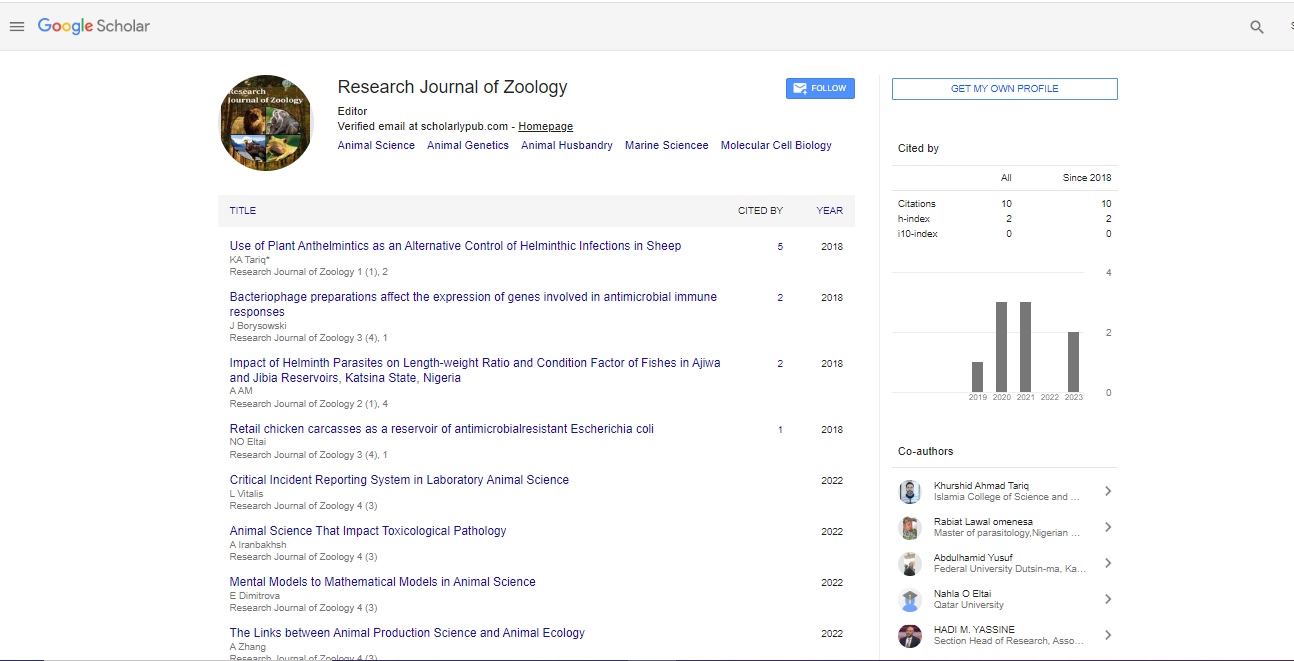Opinion Article, Res J Zool Vol: 5 Issue: 1
Mechanism of Gene Expression in Eukaryotic Cells
Joseph Mostia*
1Department of Medical Microbiology and Immunology, Menoufia University, Menofia, Egypt
*Corresponding Author: Joseph Mostia
Department of Medical Microbiology and
Immunology, Menoufia University, Menofia, Egypt;
E-mail: josephmostiagmail.com
Received date: 20-Feb-2023, Manuscript No. RJZ-23-93774;
Editor assigned date: 22-Feb-2023, PreQC No. RJZ-23-93774 (PQ);
Reviewed date: 09-Mar-2023, QC No RJZ-23-93774;
Revised date: 16-Mar-2023, Manuscript No. RJZ-23-93774(R);
Published date: 23-Mar-2023, DOI: 10.4172/Rjz.1000072.
Citation: Mostia J (2023) Mechanism of Gene Expression in Eukaryotic Cells. Res J Zool 5:1.
Description
The expression of eukaryotic genes is mainly controlled at the level of transcription initiation, though transcription may be attenuated and regulated at later stages in some instances. Transcription in eukaryotic cells, like in bacteria, is regulated by proteins that bind to particular regulatory sequences and modulate the activity of RNA polymerase. The complex job of regulating gene expression in multicellular organisms' many differentiated cell types is mainly accomplished by the combined actions of multiple different transcriptional regulatory proteins. Furthermore, the packaging of DNA into chromatin and its modification by methylation contribute to the complexity of controlling eukaryotic gene expression. The process of turning genes on and off is known as gene regulation. Gene regulation can occur at any point during the transcription-translation process, but it most commonly happens during transcription. Transcription factors are proteins that can be triggered by other cells and environmental signals. Transcription factors bind to gene regulatory regions and increase or reduce transcription. Other methods of gene regulation include controlling RNA processing, mRNA stability, and translation rate. Turning the right genes on and off is critical to sustaining a cell's functionality. Gene expression regulation conserves both energy and room. It saves energy by turning on genes only when they are needed. Furthermore, expressing only a subset of genes in each cell saves room because DNA must be unwound from its tightly coiled structure in order to be transcribed and translated. If every protein was expressed in every cell all of the time, cells would have to be huge. The regulation of gene expression is exceedingly complicated. Failures in this process are harmful to the cell and can contribute to the development of a variety of diseases, including cancer.
Proteins must be synthesised at the correct time for a cell to function correctly. All cells use information encoded in their DNA to govern or modulate protein synthesis. Gene expression refers to the process of turning on a gene to generate RNA and protein. Each cell controls when and how its genes are expressed, whether in a basic unicellular organism or a complex multicellular organism. To accomplish this, a mechanism must be in place to regulate when a gene is expressed to produce RNA and protein, how much protein is produced, and when it is time to stop producing that protein because it is no longer required.
Gene expression regulation conserves both energy and room. Because it would take a considerable amount of energy for an organism to express every gene all of the time, it is more energy efficient to turn the genes on only when they are needed. Furthermore, expressing only a subset of genes in each cell saves room because DNA must be unwound from its tightly coiled structure in order to be transcribed and translated. If every protein was expressed in every cell all of the time, cells would have to be huge.
Epigenetic alterations
An epigenetic change is a type of DNA modification that happens when a chemical compound or protein binds to a gene and changes its expression. The DNA sequence is not altered; rather, a chemical or protein is linked to the DNA. Epigenetic changes can be handed down through inheritance or occur as a consequence of exposure to environmental substances, lifestyle choices, or ageing. The modification of histone proteins is the best-studied illustration of epigenetic regulation. Histones are chromosomal proteins that closely wind DNA to fit it into a cell's nucleus. For example, the human genome contains over three billion nucleotide pairs. Each chromosome has 130 million nucleotide pairs on average, and each bodily cell has 46 chromosomes. A typical human chromosome would be over four centimetres long if stretched out linearly. To squeeze all of this DNA into a microscopic cell's nucleus, the DNA must be tightly wound around proteins.
 Spanish
Spanish  Chinese
Chinese  Russian
Russian  German
German  French
French  Japanese
Japanese  Portuguese
Portuguese  Hindi
Hindi 
